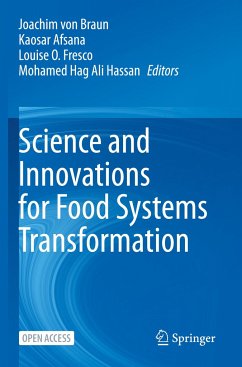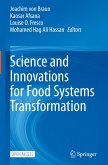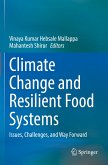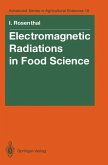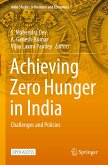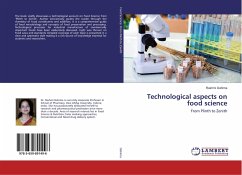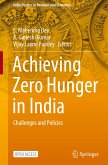Science and Innovations for Food Systems Transformation
Herausgeber: Braun, Joachim Von; Afsana, Kaosar; Fresco, Louise O.; Hassan, Mohamed Hag Ali
Science and Innovations for Food Systems Transformation
Herausgeber: Braun, Joachim Von; Afsana, Kaosar; Fresco, Louise O.; Hassan, Mohamed Hag Ali
- Broschiertes Buch
- Merkliste
- Auf die Merkliste
- Bewerten Bewerten
- Teilen
- Produkt teilen
- Produkterinnerung
- Produkterinnerung
This Open Access book compiles the findings of the Scientific Group of the United Nations Food Systems Summit 2021 and its research partners. The Scientific Group was an independent group of 28 food systems scientists from all over the world with a mandate from the Deputy Secretary-General of the United Nations. The chapters provide science- and research-based, state-of-the-art, solution-oriented knowledge and evidence to inform the transformation of contemporary food systems in order to achieve more sustainable, equitable and resilient systems.
Andere Kunden interessierten sich auch für
![Science and Innovations for Food Systems Transformation Science and Innovations for Food Systems Transformation]() Science and Innovations for Food Systems Transformation41,99 €
Science and Innovations for Food Systems Transformation41,99 €![Climate Change and Resilient Food Systems Climate Change and Resilient Food Systems]() Climate Change and Resilient Food Systems177,99 €
Climate Change and Resilient Food Systems177,99 €![Climate Change and Resilient Food Systems Climate Change and Resilient Food Systems]() Climate Change and Resilient Food Systems127,99 €
Climate Change and Resilient Food Systems127,99 €![Electromagnetic Radiations in Food Science Electromagnetic Radiations in Food Science]() Ionel RosenthalElectromagnetic Radiations in Food Science81,99 €
Ionel RosenthalElectromagnetic Radiations in Food Science81,99 €![Achieving Zero Hunger in India Achieving Zero Hunger in India]() Achieving Zero Hunger in India31,99 €
Achieving Zero Hunger in India31,99 €![Technological aspects on food science Technological aspects on food science]() Rashmi DahimaTechnological aspects on food science34,99 €
Rashmi DahimaTechnological aspects on food science34,99 €![Achieving Zero Hunger in India Achieving Zero Hunger in India]() Achieving Zero Hunger in India39,99 €
Achieving Zero Hunger in India39,99 €-
-
-
This Open Access book compiles the findings of the Scientific Group of the United Nations Food Systems Summit 2021 and its research partners. The Scientific Group was an independent group of 28 food systems scientists from all over the world with a mandate from the Deputy Secretary-General of the United Nations. The chapters provide science- and research-based, state-of-the-art, solution-oriented knowledge and evidence to inform the transformation of contemporary food systems in order to achieve more sustainable, equitable and resilient systems.
Hinweis: Dieser Artikel kann nur an eine deutsche Lieferadresse ausgeliefert werden.
Hinweis: Dieser Artikel kann nur an eine deutsche Lieferadresse ausgeliefert werden.
Produktdetails
- Produktdetails
- Verlag: Springer International Publishing / Springer Nature Switzerland
- 1st ed. 2023
- Seitenzahl: 972
- Erscheinungstermin: 3. Januar 2023
- Englisch
- Abmessung: 235mm x 155mm x 49mm
- Gewicht: 1616g
- ISBN-13: 9783031157059
- ISBN-10: 3031157052
- Artikelnr.: 64545697
- Herstellerkennzeichnung Die Herstellerinformationen sind derzeit nicht verfügbar.
- Verlag: Springer International Publishing / Springer Nature Switzerland
- 1st ed. 2023
- Seitenzahl: 972
- Erscheinungstermin: 3. Januar 2023
- Englisch
- Abmessung: 235mm x 155mm x 49mm
- Gewicht: 1616g
- ISBN-13: 9783031157059
- ISBN-10: 3031157052
- Artikelnr.: 64545697
- Herstellerkennzeichnung Die Herstellerinformationen sind derzeit nicht verfügbar.
Joachim von Braun (Germany) served as the Chair of the Scientific Group. He is a Distinguished Professor at and formerly the Director of the Center for Development Research (ZEF), Bonn University. His research focuses on economic developmen.- t, science, and technology policy, poverty reduction, food and nutrition security, resource economics, and trade. von Braun is President of the Pontifical Academy of Sciences of the Vatican; a member of the German National Academy of Science - Leopoldina, the Academy of Science and Engineering (acatech), the Academy of Arts and Science North Rhine-Westphalia, and a fellow of the African Academy of Science and of the American Association for the Advancement of Sciences. He is Vice President of the German NGO "Welthungerhilfe". Previously, he was Director-General of the International Food Policy Research Institute (IFPRI). He was elected as president of the International Association of Agricultural Economists (IAAE) and received honorary degrees and several other awards. Kaosar Afsana (Bangladesh) served as a Vice-Chair of the Scientific Group. She is a Professor at the James P Grant School of Public Health (JPGSPH), BRAC University. Dr. Afsana had served BRAC in Bangladesh for over 26 years and completed her tenure as the Director of the BRAC Health, Nutrition, and Population Programme. Dr. Afsana started work for BRAC JPGSPH at its inception in 2004. She is an MD with an MPH from Harvard University, USA, and a Ph.D. from Edith Cowan University, Australia. She represents BRAC JPGSPH and BRAC at the national and global level, playing a critical role in policy-making and planning, and in providing technical guidance, particularly, regarding sexual, reproductive, maternal, neonatal, child and adolescent health, and nutrition and health system strengthening. Louise O. Fresco (Netherlands) served as a Vice-Chair of the Scientific Group. Sheis the President of the Executive Board of Wageningen University & Research in The Netherlands. Louise combines a long academic career as a professor at Wageningen and other institutions with extensive involvement in policy and development, with many programs in Africa, Asia, and Latin America and teaching in Sweden, Belgium, and the US. Louise O. Fresco is a member of eight Scientific Academies and holds four honorary doctorates. Ten years of her career were spent at the Food and Agriculture Organisation of the UN. She is a non-Executive Director on the board of Syngenta as well as of various philanthropies while previously she served on the supervisory boards of companies like Rabobank and Unilever and on the board of the Royal Concertgebouw Orchestra. Her successful book "Hamburgers in Paradise, the stories behind the food we eat" was translated into several languages. In total, she published thirteen books of fiction and non-fiction, and she also writes a bi-weekly column in NRC,the leading evening paper in The Netherlands. She presented a six-part documentary on food and development for Dutch public television (to be found in translation on her website www.louiseofresco.com). You may have seen her TED talk in Palm Springs in 2009. Mohamed Hassan (Sudan) served as a Vice-Chair of the Scientific Group. He is President of The World Academy of Sciences (TWAS), Italy; President of the Sudanese National Academy of Sciences (SNAS); Chairman of the Governing Council of the United Nations Technology Bank, Turkey; and Chairman of the International Advisory Board of the Center for Development Research (ZEF), Germany. He was Professor and Dean of the School of Mathematical Sciences, University of Khartoum; President of the InterAcademy Partnership (IAP); founding Executive Director of TWAS; President of the African Academy of Sciences (AAS); founding President of the Network of African Science Academies (NASAC); Chairman of the Council of the United Nations University (UNU); and Chairman of the Honorary Presidential Advisory Council for Science and Technology, Nigeria. Among his honours: the Commendatore Grand Cross, and National Order of Scientific Merit, Brazil; and Officer, Order of Merit of the Italian Republic. He is a recipient of the G77 Leadership Award and the Abdus Salam Medal for Science and Technology. He is a member of eleven merit-based academies of science, which include the Academy of Sciences of South Africa; the Pontifical Academy of Sciences; and the Hassan II Academy of Science and Technology.
Part I : FOOD SYSTEM CONCEPT AND SUMMARIZED RECOMMENDATIONS.
Chapter 1: Food systems: seven priorities to end hunger and protect the planet.
Chapter 2: Food system concepts and definitions for science and political action.
Part II: ACTIONS ON HUNGER AND HEALTHY DIETS.
Chapter 3: Healthy diet
A Definition for the United Nations Food Systems Summit 2021.
Chapter 4: Ensuring Access to Safe and Nutritious Food for All Through Transformation of Food Systems.
Chapter 5: Shift to Healthy and Sustainable Consumption Patterns.
Chapter 6: Fruits and Vegetables for Healthy Diets: Priorities for Food System Research and Action.
Chapter 7: Modelling Actions for Transforming Agrifood Systems.
Part IV: ACTIONS FOR EQUITY AND RESILIENCE IN FOOD SYSTEMS.
Chapter 8: Advance Equitable Livelihoods.
Chapter 9: A Review of Evidence on Gender Equality, Women's Empowerment and Food Systems.
Chapter 10: The Future of Small Farms: Innovations for Inclusive Transformation.
Chapter 11: Diversification for enhanced food systems resilience.
Chapter 12: Addressing Food Crises in Violent Conflicts.
Chapter 13: In brief: The White/Wiphala Paper on Indigenous Peoples' food systems.
Chapter 14: Marginal areas and indigenous people
Priorities for research and action.
Chapter 15: Priorities for inclusive urban food system transformations in the Global South.
Chapter 16: Secondary Cities as Catalysts for Nutritious Diets in Low
And Middle
Income Countries.
Part V: ACTIONS FOR SUSTAINABLE FOOD PRODUCTION AND RESOURCE MANAGEMENT.
Chapter 17: Boost Nature Positive Production. Chapter 18: Pathways to Advance Agroecology for a Successful Transformation to Sustainable Food Systems.
Chapter 19: A New Paradigm for Plant Nutrition.
Chapter 20: Livestock and sustainable food systems: status, trends, and priority actions.
Chapter 21: The Vital Roles of Blue Foods in the Global Food System.
Chapter 22: Food System Innovations and Digital Technologies to Foster Productivity Growth and Rural Transformation.
Chapter 23: Leveraging data, models & farming innovation to prevent, prepare for & manage pest incursions: Delivering a pest risk service for low
income countries.
Chapter 24: Food Systems Innovation Hubs in Low
and
Middle
Income Countries.
Chapter 25: A Whole Earth Approach to Nature Positive Food: Biodiversity and Agriculture.
Chapter 26: Water for Food Systems and Nutrition.
Chapter 27: Climate Change and Food Systems .
Chapter 28: Delivering climate change outcomes with agroecology in low
and middle
income countries: evidence and actions needed.
Chapter 29: Crop Diversity, its Conservation and Use for Better Food Systems.
Chapter 30: Safeguarding and using Fruit and Vegetable Biodiversity.
Chapter 31: Reduction of Food Loss and Waste
The Challenges and Conclusions for Actions.
Part V: COSTS, INVESTMENT, FINANCE, AND TRADE ACTIONS.
Chapter 32: The True Cost of Food
a preliminary assessment.
Chapter 33: Cost and Affordability of Preparing a Basic Meal around the World.
Chapter 34: The global cost of reaching a world without hunger: Investment costs and policy action opportunities.
Chapter 35: Financing SGD2 and Ending Hunger.
Chapter 36: Trade and Sustainable Food Systems.
Part VI: Regional Perspectives.
Chapter 37: Policy Options for food system transformation in Africa and the role of science, technology and innovation.
Chapter 38: The Role of Science, Technology and Innovation for Transforming Food Systems in Latin America and the Caribbean.
Chapter 39: The Role of Science, Technology, and Innovation for Transforming Food Systems in Asia.
Chapter 40: The Role of Science, Technology, and Innovation for Transforming Food Systems in Europe.
Chapter 41: Transforming Chinese Food Systems for both Human and Planetary Health.
Chapter 42: Key Areas of the Agricultural Science Development in Russia in the Context of Global Trends and Challenges.
Chapter 43: Food System in India. Challenges, Performance and Promise.
Part VII: STRATEGIC PERSPECTIVES AND GOVERNANCE.
Chapter 44: The Role of Science, Technology and Innovation for Transforming Food Systems Globally.
Chapter 45: The Bioeconomy and Food Systems Transformation.
Chapter 46: In the Age of Pandemics, connecting Food Systems and Health: a Global One Health Approach.
Chapter 47: How could science
policy interfaces boost food system transformation?.
Chapter 48: The Transition Steps Needed to Transform Our Food Systems.
Chapter 49: Engaging Science in Food Systems Transformation: Toward Implementation of the Action Agenda of the United Nations Food Systems Summit.
Chapter 50: Science for Transformation of Food Systems: Opportunities for the UN Food Systems Summit.
Chapter 1: Food systems: seven priorities to end hunger and protect the planet.
Chapter 2: Food system concepts and definitions for science and political action.
Part II: ACTIONS ON HUNGER AND HEALTHY DIETS.
Chapter 3: Healthy diet
A Definition for the United Nations Food Systems Summit 2021.
Chapter 4: Ensuring Access to Safe and Nutritious Food for All Through Transformation of Food Systems.
Chapter 5: Shift to Healthy and Sustainable Consumption Patterns.
Chapter 6: Fruits and Vegetables for Healthy Diets: Priorities for Food System Research and Action.
Chapter 7: Modelling Actions for Transforming Agrifood Systems.
Part IV: ACTIONS FOR EQUITY AND RESILIENCE IN FOOD SYSTEMS.
Chapter 8: Advance Equitable Livelihoods.
Chapter 9: A Review of Evidence on Gender Equality, Women's Empowerment and Food Systems.
Chapter 10: The Future of Small Farms: Innovations for Inclusive Transformation.
Chapter 11: Diversification for enhanced food systems resilience.
Chapter 12: Addressing Food Crises in Violent Conflicts.
Chapter 13: In brief: The White/Wiphala Paper on Indigenous Peoples' food systems.
Chapter 14: Marginal areas and indigenous people
Priorities for research and action.
Chapter 15: Priorities for inclusive urban food system transformations in the Global South.
Chapter 16: Secondary Cities as Catalysts for Nutritious Diets in Low
And Middle
Income Countries.
Part V: ACTIONS FOR SUSTAINABLE FOOD PRODUCTION AND RESOURCE MANAGEMENT.
Chapter 17: Boost Nature Positive Production. Chapter 18: Pathways to Advance Agroecology for a Successful Transformation to Sustainable Food Systems.
Chapter 19: A New Paradigm for Plant Nutrition.
Chapter 20: Livestock and sustainable food systems: status, trends, and priority actions.
Chapter 21: The Vital Roles of Blue Foods in the Global Food System.
Chapter 22: Food System Innovations and Digital Technologies to Foster Productivity Growth and Rural Transformation.
Chapter 23: Leveraging data, models & farming innovation to prevent, prepare for & manage pest incursions: Delivering a pest risk service for low
income countries.
Chapter 24: Food Systems Innovation Hubs in Low
and
Middle
Income Countries.
Chapter 25: A Whole Earth Approach to Nature Positive Food: Biodiversity and Agriculture.
Chapter 26: Water for Food Systems and Nutrition.
Chapter 27: Climate Change and Food Systems .
Chapter 28: Delivering climate change outcomes with agroecology in low
and middle
income countries: evidence and actions needed.
Chapter 29: Crop Diversity, its Conservation and Use for Better Food Systems.
Chapter 30: Safeguarding and using Fruit and Vegetable Biodiversity.
Chapter 31: Reduction of Food Loss and Waste
The Challenges and Conclusions for Actions.
Part V: COSTS, INVESTMENT, FINANCE, AND TRADE ACTIONS.
Chapter 32: The True Cost of Food
a preliminary assessment.
Chapter 33: Cost and Affordability of Preparing a Basic Meal around the World.
Chapter 34: The global cost of reaching a world without hunger: Investment costs and policy action opportunities.
Chapter 35: Financing SGD2 and Ending Hunger.
Chapter 36: Trade and Sustainable Food Systems.
Part VI: Regional Perspectives.
Chapter 37: Policy Options for food system transformation in Africa and the role of science, technology and innovation.
Chapter 38: The Role of Science, Technology and Innovation for Transforming Food Systems in Latin America and the Caribbean.
Chapter 39: The Role of Science, Technology, and Innovation for Transforming Food Systems in Asia.
Chapter 40: The Role of Science, Technology, and Innovation for Transforming Food Systems in Europe.
Chapter 41: Transforming Chinese Food Systems for both Human and Planetary Health.
Chapter 42: Key Areas of the Agricultural Science Development in Russia in the Context of Global Trends and Challenges.
Chapter 43: Food System in India. Challenges, Performance and Promise.
Part VII: STRATEGIC PERSPECTIVES AND GOVERNANCE.
Chapter 44: The Role of Science, Technology and Innovation for Transforming Food Systems Globally.
Chapter 45: The Bioeconomy and Food Systems Transformation.
Chapter 46: In the Age of Pandemics, connecting Food Systems and Health: a Global One Health Approach.
Chapter 47: How could science
policy interfaces boost food system transformation?.
Chapter 48: The Transition Steps Needed to Transform Our Food Systems.
Chapter 49: Engaging Science in Food Systems Transformation: Toward Implementation of the Action Agenda of the United Nations Food Systems Summit.
Chapter 50: Science for Transformation of Food Systems: Opportunities for the UN Food Systems Summit.
Part I : FOOD SYSTEM CONCEPT AND SUMMARIZED RECOMMENDATIONS.
Chapter 1: Food systems: seven priorities to end hunger and protect the planet.
Chapter 2: Food system concepts and definitions for science and political action.
Part II: ACTIONS ON HUNGER AND HEALTHY DIETS.
Chapter 3: Healthy diet
A Definition for the United Nations Food Systems Summit 2021.
Chapter 4: Ensuring Access to Safe and Nutritious Food for All Through Transformation of Food Systems.
Chapter 5: Shift to Healthy and Sustainable Consumption Patterns.
Chapter 6: Fruits and Vegetables for Healthy Diets: Priorities for Food System Research and Action.
Chapter 7: Modelling Actions for Transforming Agrifood Systems.
Part IV: ACTIONS FOR EQUITY AND RESILIENCE IN FOOD SYSTEMS.
Chapter 8: Advance Equitable Livelihoods.
Chapter 9: A Review of Evidence on Gender Equality, Women's Empowerment and Food Systems.
Chapter 10: The Future of Small Farms: Innovations for Inclusive Transformation.
Chapter 11: Diversification for enhanced food systems resilience.
Chapter 12: Addressing Food Crises in Violent Conflicts.
Chapter 13: In brief: The White/Wiphala Paper on Indigenous Peoples' food systems.
Chapter 14: Marginal areas and indigenous people
Priorities for research and action.
Chapter 15: Priorities for inclusive urban food system transformations in the Global South.
Chapter 16: Secondary Cities as Catalysts for Nutritious Diets in Low
And Middle
Income Countries.
Part V: ACTIONS FOR SUSTAINABLE FOOD PRODUCTION AND RESOURCE MANAGEMENT.
Chapter 17: Boost Nature Positive Production. Chapter 18: Pathways to Advance Agroecology for a Successful Transformation to Sustainable Food Systems.
Chapter 19: A New Paradigm for Plant Nutrition.
Chapter 20: Livestock and sustainable food systems: status, trends, and priority actions.
Chapter 21: The Vital Roles of Blue Foods in the Global Food System.
Chapter 22: Food System Innovations and Digital Technologies to Foster Productivity Growth and Rural Transformation.
Chapter 23: Leveraging data, models & farming innovation to prevent, prepare for & manage pest incursions: Delivering a pest risk service for low
income countries.
Chapter 24: Food Systems Innovation Hubs in Low
and
Middle
Income Countries.
Chapter 25: A Whole Earth Approach to Nature Positive Food: Biodiversity and Agriculture.
Chapter 26: Water for Food Systems and Nutrition.
Chapter 27: Climate Change and Food Systems .
Chapter 28: Delivering climate change outcomes with agroecology in low
and middle
income countries: evidence and actions needed.
Chapter 29: Crop Diversity, its Conservation and Use for Better Food Systems.
Chapter 30: Safeguarding and using Fruit and Vegetable Biodiversity.
Chapter 31: Reduction of Food Loss and Waste
The Challenges and Conclusions for Actions.
Part V: COSTS, INVESTMENT, FINANCE, AND TRADE ACTIONS.
Chapter 32: The True Cost of Food
a preliminary assessment.
Chapter 33: Cost and Affordability of Preparing a Basic Meal around the World.
Chapter 34: The global cost of reaching a world without hunger: Investment costs and policy action opportunities.
Chapter 35: Financing SGD2 and Ending Hunger.
Chapter 36: Trade and Sustainable Food Systems.
Part VI: Regional Perspectives.
Chapter 37: Policy Options for food system transformation in Africa and the role of science, technology and innovation.
Chapter 38: The Role of Science, Technology and Innovation for Transforming Food Systems in Latin America and the Caribbean.
Chapter 39: The Role of Science, Technology, and Innovation for Transforming Food Systems in Asia.
Chapter 40: The Role of Science, Technology, and Innovation for Transforming Food Systems in Europe.
Chapter 41: Transforming Chinese Food Systems for both Human and Planetary Health.
Chapter 42: Key Areas of the Agricultural Science Development in Russia in the Context of Global Trends and Challenges.
Chapter 43: Food System in India. Challenges, Performance and Promise.
Part VII: STRATEGIC PERSPECTIVES AND GOVERNANCE.
Chapter 44: The Role of Science, Technology and Innovation for Transforming Food Systems Globally.
Chapter 45: The Bioeconomy and Food Systems Transformation.
Chapter 46: In the Age of Pandemics, connecting Food Systems and Health: a Global One Health Approach.
Chapter 47: How could science
policy interfaces boost food system transformation?.
Chapter 48: The Transition Steps Needed to Transform Our Food Systems.
Chapter 49: Engaging Science in Food Systems Transformation: Toward Implementation of the Action Agenda of the United Nations Food Systems Summit.
Chapter 50: Science for Transformation of Food Systems: Opportunities for the UN Food Systems Summit.
Chapter 1: Food systems: seven priorities to end hunger and protect the planet.
Chapter 2: Food system concepts and definitions for science and political action.
Part II: ACTIONS ON HUNGER AND HEALTHY DIETS.
Chapter 3: Healthy diet
A Definition for the United Nations Food Systems Summit 2021.
Chapter 4: Ensuring Access to Safe and Nutritious Food for All Through Transformation of Food Systems.
Chapter 5: Shift to Healthy and Sustainable Consumption Patterns.
Chapter 6: Fruits and Vegetables for Healthy Diets: Priorities for Food System Research and Action.
Chapter 7: Modelling Actions for Transforming Agrifood Systems.
Part IV: ACTIONS FOR EQUITY AND RESILIENCE IN FOOD SYSTEMS.
Chapter 8: Advance Equitable Livelihoods.
Chapter 9: A Review of Evidence on Gender Equality, Women's Empowerment and Food Systems.
Chapter 10: The Future of Small Farms: Innovations for Inclusive Transformation.
Chapter 11: Diversification for enhanced food systems resilience.
Chapter 12: Addressing Food Crises in Violent Conflicts.
Chapter 13: In brief: The White/Wiphala Paper on Indigenous Peoples' food systems.
Chapter 14: Marginal areas and indigenous people
Priorities for research and action.
Chapter 15: Priorities for inclusive urban food system transformations in the Global South.
Chapter 16: Secondary Cities as Catalysts for Nutritious Diets in Low
And Middle
Income Countries.
Part V: ACTIONS FOR SUSTAINABLE FOOD PRODUCTION AND RESOURCE MANAGEMENT.
Chapter 17: Boost Nature Positive Production. Chapter 18: Pathways to Advance Agroecology for a Successful Transformation to Sustainable Food Systems.
Chapter 19: A New Paradigm for Plant Nutrition.
Chapter 20: Livestock and sustainable food systems: status, trends, and priority actions.
Chapter 21: The Vital Roles of Blue Foods in the Global Food System.
Chapter 22: Food System Innovations and Digital Technologies to Foster Productivity Growth and Rural Transformation.
Chapter 23: Leveraging data, models & farming innovation to prevent, prepare for & manage pest incursions: Delivering a pest risk service for low
income countries.
Chapter 24: Food Systems Innovation Hubs in Low
and
Middle
Income Countries.
Chapter 25: A Whole Earth Approach to Nature Positive Food: Biodiversity and Agriculture.
Chapter 26: Water for Food Systems and Nutrition.
Chapter 27: Climate Change and Food Systems .
Chapter 28: Delivering climate change outcomes with agroecology in low
and middle
income countries: evidence and actions needed.
Chapter 29: Crop Diversity, its Conservation and Use for Better Food Systems.
Chapter 30: Safeguarding and using Fruit and Vegetable Biodiversity.
Chapter 31: Reduction of Food Loss and Waste
The Challenges and Conclusions for Actions.
Part V: COSTS, INVESTMENT, FINANCE, AND TRADE ACTIONS.
Chapter 32: The True Cost of Food
a preliminary assessment.
Chapter 33: Cost and Affordability of Preparing a Basic Meal around the World.
Chapter 34: The global cost of reaching a world without hunger: Investment costs and policy action opportunities.
Chapter 35: Financing SGD2 and Ending Hunger.
Chapter 36: Trade and Sustainable Food Systems.
Part VI: Regional Perspectives.
Chapter 37: Policy Options for food system transformation in Africa and the role of science, technology and innovation.
Chapter 38: The Role of Science, Technology and Innovation for Transforming Food Systems in Latin America and the Caribbean.
Chapter 39: The Role of Science, Technology, and Innovation for Transforming Food Systems in Asia.
Chapter 40: The Role of Science, Technology, and Innovation for Transforming Food Systems in Europe.
Chapter 41: Transforming Chinese Food Systems for both Human and Planetary Health.
Chapter 42: Key Areas of the Agricultural Science Development in Russia in the Context of Global Trends and Challenges.
Chapter 43: Food System in India. Challenges, Performance and Promise.
Part VII: STRATEGIC PERSPECTIVES AND GOVERNANCE.
Chapter 44: The Role of Science, Technology and Innovation for Transforming Food Systems Globally.
Chapter 45: The Bioeconomy and Food Systems Transformation.
Chapter 46: In the Age of Pandemics, connecting Food Systems and Health: a Global One Health Approach.
Chapter 47: How could science
policy interfaces boost food system transformation?.
Chapter 48: The Transition Steps Needed to Transform Our Food Systems.
Chapter 49: Engaging Science in Food Systems Transformation: Toward Implementation of the Action Agenda of the United Nations Food Systems Summit.
Chapter 50: Science for Transformation of Food Systems: Opportunities for the UN Food Systems Summit.

